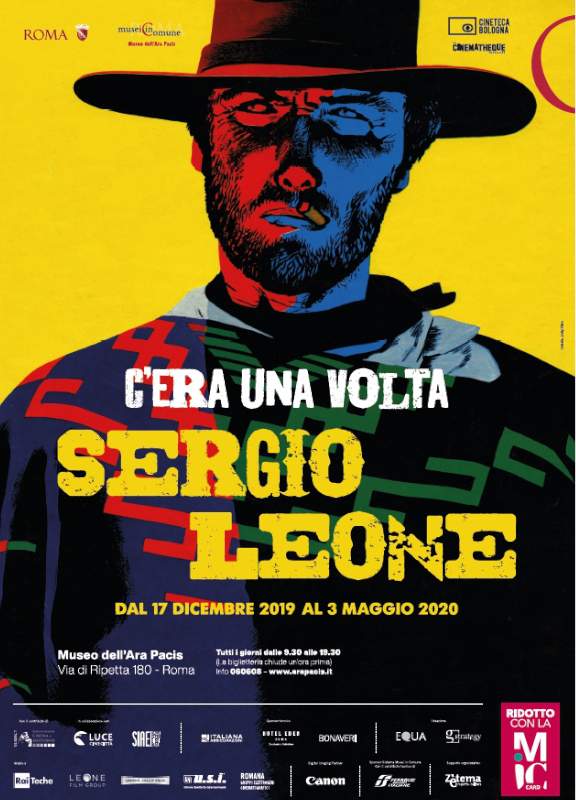Rome, at the Ara Pacis Museum an exhibition celebrates Sergio Leone's westerns.
Sergio Leone made legendary the filmic telling of the story of myths such as the West orAmerica. After more than half a century, he himself has become a myth. And Once Upon a Time Sergio Leone is the title of the major exhibition at theAra Pacis with which Rome celebrates, 30 years after his death and 90 years after his birth, one of the legends of Italian cinema, from December 17, 2019 to May 3, 2020.
Promoted by theAssessorato alla Crescita Culturale di Roma Capitale - Sovrintendenza Capitolina ai Beni Culturali, the exhibition arrives in Italy after last year’s success at the Cinémathèque Française in Paris, an institution that co-produced the Roman exhibit together with the Fondazione Cineteca di Bologna.
The exhibition, curated by the director of the Cineteca di Bologna, Gian Luca Farinelli, in collaboration with Rosaria Gioia and Antonio Bigini, tells of a boundless universe, that of Sergio Leone, rooted in his own family tradition: his father, a director in the golden age of Italian silent film, chose the pseudonym Roberto Roberti, and Sergio winked at him, signing in turn For a Fistful of Dollars under the English-speaking pseudonym Bob Robertson.
In his intense artistic journey, Sergio Leone traversed the peplum (historical-mythological film strand), literally rewrote the Western, and found his culmination in the project of a lifetime, Once Upon a Time in America. This would be followed by another film of grandiose proportions, dedicated to the Battle of Leningrad, of which only a few pages remain, unfortunately, written before his death. Leone, in fact, did not like to write. He was, rather, an oral storyteller who developed his films by telling his friends, screenwriters, and producers about them endlessly, almost like the ancient storytellers who created the Homeric epic.
The roots of Sergio Leone’s cinema are also rooted in a love of the classics of the past (films by the giants of the Western, from John Ford to Anthony Mann, are on display) and reveal a taste for architecture and ’figurative art that we find in the construction of the sets and shots, from the long shots of metaphysical landscapes suggested by De Chirico, to the explicit citation of Robert Indiana’s work Love, an extraordinary symbol, in Once Upon a Time in America, of an unequivocal leap into a new era. For Leone, the fairy tale is cinema. The desire to tell the story of myths (the West, the Revolution, America) using the memory of cinema and the freedom of the fairy tale, however, always comes into conflict with his culture as an Italian who has known war and gone through the neorealist season.
Thanks to valuable archival materials from the Leone family and Unidis Jolly Film, visitors will enter Sergio’s studio, where the ideas for his cinema were born, with his personal memorabilia and library, and then immerse themselves in his films through models, sets, sketches, costumes, props, sequences and a constellation of photographs taken by Angelo Novi, who followed all of Sergio Leone’s work starting with Once Upon a Time in the West.
Accompanying the exhibition will be published by Edizioni Cineteca di Bologna the volume La rivoluzione Sergio Leone, edited by Christopher Frayling and Gian Luca Farinelli.
The exhibition is produced with the contribution of the Ministry of Culture and Tourism, in collaboration with Istituto Luce - Cinecittà, Ministère de la culture(France), CNC - Centre national du cinéma et de l’image animée, SIAE and thanks to Rai Teche, Leone Film Group, Unidis Jolly Film, Unione Sanitaria Internazionale, Romana Gruppi Elettrogeni Cinematografici. Digital Imaging Partner: Canon. Technical Sponsors: Italiana Assicurazioni, Hotel Eden Roma, Bonaveri. The conception is by Equa di Camilla Morabito and the organizational support by Zètema Progetto cultura.
For all information you can visit the official website of the Ara Pacis Museum.
 |
| Rome, at the Ara Pacis Museum an exhibition celebrates Sergio Leone's westerns. |
Warning: the translation into English of the original Italian article was created using automatic tools. We undertake to review all articles, but we do not guarantee the total absence of inaccuracies in the translation due to the program. You can find the original by clicking on the ITA button. If you find any mistake,please contact us.




























